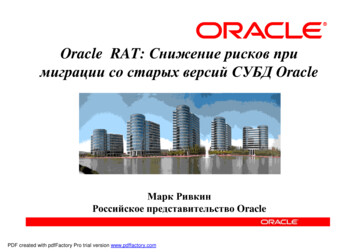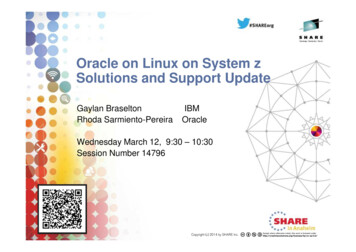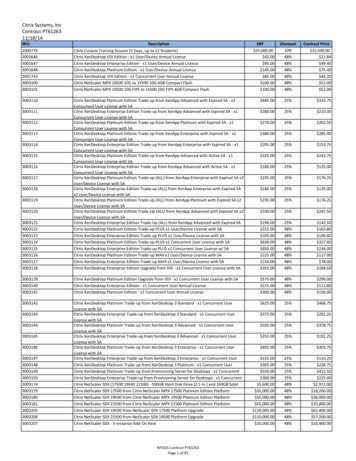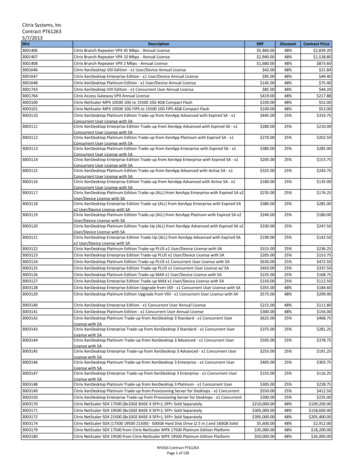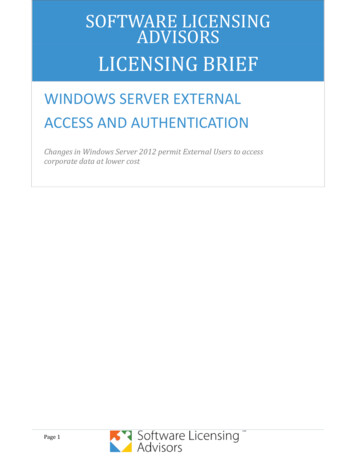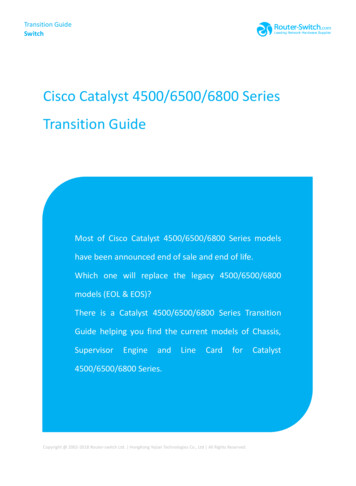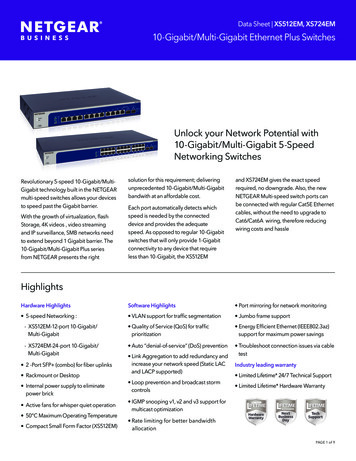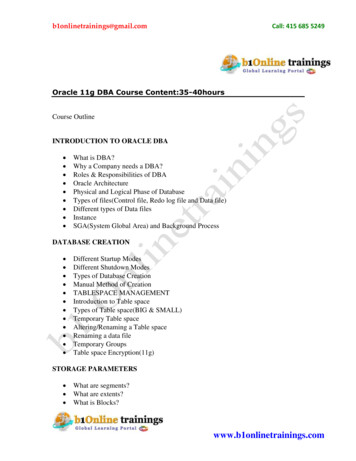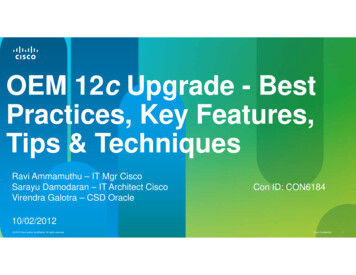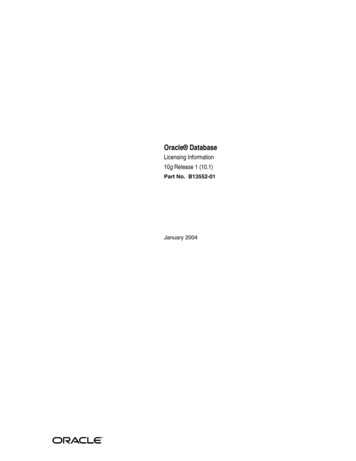
Transcription
Oracle DatabaseLicensing Information10g Release 1 (10.1)Part No. B13552-01January 2004
Oracle Database Licensing Information 10g Release 1 (10.1)Part No. B13552-01Copyright 2004 Oracle. All rights reserved.Contributors: Francisco Abedrabbo, Manmeet Ahluwalia, Dorena Chan, Sandra Cheevers, Sudha Iyer,Sushil Kumar, Trish McGonigle, Paul Needham, Karen Scarr, Gordon Smith, Mark Townsend, JacquelineWoodsThe Programs (which include both the software and documentation) contain proprietary information; theyare provided under a license agreement containing restrictions on use and disclosure and are also protectedby copyright, patent, and other intellectual and industrial property laws. Reverse engineering, disassembly,or decompilation of the Programs, except to the extent required to obtain interoperability with otherindependently created software or as specified by law, is prohibited.The information contained in this document is subject to change without notice. If you find any problems inthe documentation, please report them to us in writing. This document is not warranted to be error-free.Except as may be expressly permitted in your license agreement for these Programs, no part of thesePrograms may be reproduced or transmitted in any form or by any means, electronic or mechanical, for anypurpose.If the Programs are delivered to the United States Government or anyone licensing or using the Programs onbehalf of the United States Government, the following notice is applicable:U.S. GOVERNMENT RIGHTS Programs, software, databases, and related documentation and technical datadelivered to U.S. Government customers are "commercial computer software" or "commercial technicaldata" pursuant to the applicable Federal Acquisition Regulation and agency-specific supplementalregulations. As such, use, duplication, disclosure, modification, and adaptation of the Programs, includingdocumentation and technical data, shall be subject to the licensing restrictions set forth in the applicableOracle license agreement, and, to the extent applicable, the additional rights set forth in FAR 52.227-19,Commercial Computer Software--Restricted Rights (June 1987). Oracle Corporation, 500 Oracle Parkway,Redwood City, CA 94065The Programs are not intended for use in any nuclear, aviation, mass transit, medical, or other inherentlydangerous applications. It shall be the licensee's responsibility to take all appropriate fail-safe, backup,redundancy and other measures to ensure the safe use of such applications if the Programs are used for suchpurposes, and we disclaim liability for any damages caused by such use of the Programs.Oracle is a registered trademark of Oracle Corporation and/or its affiliates. Other names may be trademarksof their respective owners.The Programs may provide links to Web sites and access to content, products, and services from thirdparties. Oracle is not responsible for the availability of, or any content provided on, third-party Web sites.You bear all risks associated with the use of such content. If you choose to purchase any products or servicesfrom a third party, the relationship is directly between you and the third party. Oracle is not responsible for:(a) the quality of third-party products or services; or (b) fulfilling any of the terms of the agreement with thethird party, including delivery of products or services and warranty obligations related to purchasedproducts or services. Oracle is not responsible for any loss or damage of any sort that you may incur fromdealing with any third party.
ContentsSend Us Your Comments . vPreface . viiIntended Audience. viiDocumentation Accessibility . viiStructure . viiiRelated Documents . viiiConventions . viii1Oracle Database EditionsThe Oracle Database Product Family .Feature Availability by Edition .Restricted-Use Licensing .General Licensing Information .21-11-21-51-5Options and PacksOracle Database Options . 2-1Oracle Management Packs . 2-3Other Oracle Products . 2-7Indexiii
iv
Send Us Your CommentsOracle Database Licensing Information 10g Release 1 (10.1)Part No. B13552-01Oracle welcomes your comments and suggestions on the quality and usefulness of thispublication. Your input is an important part of the information used for revision. Did you find any errors? Is the information clearly presented? Do you need more information? If so, where? Are the examples correct? Do you need more examples? What features did you like most about this manual?If you find any errors or have any other suggestions for improvement, please indicatethe title and part number of the documentation and the chapter, section, and pagenumber (if available). You can send comments to us in the following ways: Electronic mail: infodev us@oracle.com FAX: (650) 506-7227. Attn: Server Technologies Documentation Manager Postal service:Oracle CorporationServer Technologies Documentation Manager500 Oracle Parkway, Mailstop 4op11Redwood Shores, CA 94065USAIf you would like a reply, please give your name, address, telephone number, andelectronic mail address (optional).If you have problems with the software, please contact your local Oracle SupportServices.v
vi
PrefaceThis document, which is part of the Program Documentation under the terms of yourOracle licensing agreement, is intended to help you understand the features,functionality, and options available for Oracle Programs and the licenses required touse them. Oracle offers a variety of licensing options that determine your rights to runthe Oracle Programs. If you have a question about your licensing needs, please contactyour Oracle sales representative or refer to the resources listed in the "RelatedDocuments" section below for more information.Oracle Database 10g is available in multiple editions, each suitable for differentdevelopment and deployment scenarios. Oracle also offers several database optionsand packs that enhance the capabilities of Oracle Database for specific applicationrequirements. Oracle Database Licensing Information provides information on theseoptional database products and their licensing requirements.This Preface contains these topics: Intended Audience Documentation Accessibility Structure Related Documents ConventionsIntended AudienceThis book is intended for all purchasers of Oracle Database 10g.Documentation AccessibilityOur goal is to make Oracle products, services, and supporting documentationaccessible, with good usability, to the disabled community. To that end, ourdocumentation includes features that make information available to users of assistivetechnology. This documentation is available in HTML format, and contains markup tofacilitate access by the disabled community. Standards will continue to evolve overtime, and Oracle is actively engaged with other market-leading technology vendors toaddress technical obstacles so that our documentation can be accessible to all of ourcustomers. For additional information, visit the Oracle Accessibility Program Web siteathttp://www.oracle.com/accessibility/vii
Accessibility of Links to External Web Sites in Documentation This documentationmay contain links to Web sites of other companies or organizations that Oracle doesnot own or control. Oracle neither evaluates nor makes any representations regardingthe accessibility of these Web sites.StructureThis document contains two chapters:Chapter 1, "Oracle Database Editions"This chapter describes the Oracle Database editions.Chapter 2, "Options and Packs"This chapter describes the Oracle Database options and packs and their availability.Related DocumentsFor more information, see these Oracle resources: Oracle Database New Features for information on the features new to this release ofOracle DatabaseThe Software Investment Guide, available Printed documentation is available for sale in the Oracle Store athttp://oraclestore.oracle.com/To download free release notes, installation documentation, white papers, or othercollateral, please visit the Oracle Technology Network (OTN). You must register onlinebefore using OTN; registration is free and can be done athttp://otn.oracle.com/membership/If you already have a username and password for OTN, then you can go directly to thedocumentation section of the OTN Web site e use various conventions in text to help you more quickly identify special terms.The following table describes those conventions and provides examples of their use.ConventionMeaningBoldBold typeface indicates terms that areWhen you specify this clause, you create andefined in the text or terms that appear in a index-organized table.glossary, or both.ItalicsItalic typeface indicates book titles oremphasis.viiiExampleOracle Database ConceptsEnsure that the recovery catalog and targetdatabase do not reside on the same disk.
idth)fontUppercase monospace typeface indicateselements supplied by the system. Suchelements include parameters, privileges,datatypes, RMAN keywords, SQLkeywords, SQL*Plus or utility commands,packages and methods, as well assystem-supplied column names, databaseobjects and structures, usernames, androles.You can specify this clause only for a NUMBERcolumn.Lowercase monospace typeface indicatesexecutables, filenames, directory names,and sample user-supplied elements. Suchelements include computer and databasenames, net service names, and connectidentifiers, as well as user-supplieddatabase objects and structures, columnnames, packages and classes, usernamesand roles, program units, and parametervalues.Enter sqlplus to start SQL*Plus.lowercasemonospace(fixed-width)fontNote: Some programmatic elements use amixture of UPPERCASE and lowercase.Enter these elements as shown.lowercaseitalicmonospace(fixed-width)fontYou can back up the database by using theBACKUP command.Query the TABLE NAME column in the USERTABLES data dictionary view.Use the DBMS STATS.GENERATE STATSprocedure.The password is specified in the orapwd file.Back up the datafiles and control files in the/disk1/oracle/dbs directory.The department id, department name, andlocation id columns are in thehr.departments table.Set the QUERY REWRITE ENABLED initializationparameter to true.Connect as oe user.The JRepUtil class implements these methods.Lowercase italic monospace font represents You can specify the parallel clause.placeholders or variables.Run old release.SQL where old releaserefers to the release you installed prior toupgrading.ix
x
1Oracle Database EditionsThis chapter describes the four Oracle Database editions and the features availablewith those editions. It contains the following sections: The Oracle Database Product Family Feature Availability by Edition Restricted-Use Licensing General Licensing InformationThe Oracle Database Product FamilyOracle Database is available in four editions, each suitable for different developmentand deployment scenarios. Oracle also offers several database options, packs, andother products that enhance the capabilities of Oracle Database for specific applicationpurposes. This section describes the Oracle Database editions. The databaseenhancement products are described in Chapter 2, "Options and Packs".Oracle Database Standard Edition Onedelivers unprecedented ease of use, power, and performance for workgroup,department-level, and Web applications. From single-server environments for smallbusiness to highly distributed branch environments, Oracle Database Standard EditionOne includes all the facilities necessary to build business-critical applications.Standard Edition One can only be licensed on servers with a maximum capacity of twoprocessors.Oracle Database Standard Edition OneOracle Database Standard Edition delivers theunprecedented ease of use, power, and performance of Standard Edition One, withsupport for larger machines and clustering of services with Real Application Clusters.Oracle Database Standard Edition can be licensed on single servers or server clustersthat have a maximum capacity of four processors. Real Application Clusters is notincluded in the Standard Edition of releases prior to Oracle Database 10g, nor is it anavailable option with those earlier releases.Oracle Database Standard EditionWhen used in a clustered server environment, Oracle Database Standard Editionrequires the use of Oracle Cluster Ready Services (CRS). Third-party clusterwaremanagement solutions are not supported. In addition, Automatic StorageManagement (ASM) must be used to manage the data stored in Oracle Database.Third-party volume managers and file systems are not supported for this purpose.CRS and ASM are required in a clustered server environment in order to facilitate theinstallation, configuration, and support of Real Application Clusters on StandardEdition.Oracle Database Editions1-1
Feature Availability by EditionOracle Database Enterprise Edition Oracle Database Enterprise Edition provides theperformance, availability, scalability, and security required for mission-criticalapplications such as high-volume online transaction processing (OLTP) applications,query-intensive data warehouses, and demanding Internet applications. OracleDatabase Enterprise Edition contains all of the components of Oracle Database, andcan be further enhanced with the purchase of the options and packs described inChapter 2, "Options and Packs".Oracle Database Personal Edition supportssingle-user development and deployment environments that require full compatibilitywith Oracle Database Standard Edition One, Oracle Database Standard Edition, andOracle Database Enterprise Edition.Oracle Database Personal EditionPersonal Edition includes all of the components that are included with EnterpriseEdition, as well as all of the options that are available with Enterprise Edition, with theexception of the Oracle Real Application Clusters option, which cannot be used withPersonal Edition. Personal Edition is available on Windows 2000, Windows NT,Windows XP, and Windows Server 2003 (32-bit and 64-bit versions). The ManagementPacks are not included in Personal Edition.Feature Availability by EditionTable 1–1 lists the features that are not available with Standard Edition or StandardEdition One. This table can help you understand the difference between the editionsand determine whether you require Enterprise Edition (or Personal Edition for asingle-user environment) for the features you need in your business.Table 1–1Features Not Available with Oracle Database Standard Edition or Standard Edition OneArea and FeatureCommentsHigh AvailabilityOracle Data GuardData Guard provides a comprehensive set of services that create,maintain, manage, and monitor one or more standby databases to enablea production Oracle Database to survive disasters and data corruption.Fast-start fault recoveryThis feature provides fast and predictable recovery from system failures.Online operationsThe following online operations are not included with Standard Editionor Standard Edition One:Backup and recovery Online index maintenance Online table organization Online table redefinitionThe following backup and recovery features are not included withStandard Edition or Standard Edition One: Block-level media recovery Parallel backup and recovery Change-aware incremental backups 1-2Licensing InformationDuplexed backup sets (backup sets can be written to multipledevices in parallel)Point-in-time tablespace recovery (a tablespace can be recovered upto a specified point in time after a failure or inadvertent transactionexecution)Trial recovery (redo is applied in memory only but is not written todisk and is easily rolled back)
Feature Availability by EditionTable 1–1 (Cont.) Features Not Available with Oracle Database Standard Edition or Standard Edition OneArea and FeatureCommentsOracle Flashback featuresThe following Oracle Flashback features are not part of Standard Editionor Standard Edition One: Oracle Flashback Table Oracle Flashback Database Oracle Flashback Transaction QuerySecurityOracle Advanced SecurityThis option is described in "Oracle Advanced Security" on page 2-2.Oracle Label SecurityThis option is described in "Oracle Label Security" on page 2-2.Virtual Private DatabaseThis feature provides functionality to create security policies thatimplement row-level security.Fine-grained auditingThis features allows the monitoring of database access based on thecontent of the data accessed.Enterprise User SecurityThis features allows the definition of enterprise users and roles.N-tier authentication authorizationThis feature preserves client identity throughout all tiers.ManageabilityOracle Change Management PackThis pack is described in "Oracle Change Management Pack" on page 2-3.Oracle Configuration ManagementPackThis pack is described in "Oracle Configuration Management Pack" onpage 2-6.Oracle Diagnostic PackThis pack is described in "Oracle Diagnostic Pack" on page 2-3.Oracle Tuning PackThis pack is described in "Oracle Tuning Pack" on page 2-5.Database Resource ManagerDatabase Resource Manager gives Oracle Database more control overresource management decisions, circumventing problems arising frominefficient operating system management.VLDB, Data Warehousing, Business IntelligenceOracle PartitioningThis option is described in "Oracle Partitioning" on page 2-1.Oracle OLAPThis option is described in "Oracle On-Line Analytical Processing(OLAP)" on page 2-2.Oracle Data MiningThis option is described in "Oracle Data Mining" on page 2-2.Data compressionThis feature provides the ability to compress tables and partitions.Bitmapped index and bitmapped joinindexThis feature provides an index type commonly used in data warehousesfor columns with low cardinality, such as ’Y’ or ’N’, to dramaticallyimprove performance gains in a data warehouse application.Export transportable tablespaceImport transportable tablespace, including cross-platform transport, isincluded with Standard Edition and Standard Edition One, but exporttransportable tablespace is not included.Asynchronous change data captureThis feature provides a framework for capturing change data, publishingit, and enabling applications to subscribe to the change data in acontrolled fashion. Change capture occurs asynchronously based on theinformation in the Oracle redo logs.Summary managementSummary management consists of mechanisms to define materializedviews and dimensions, refresh and query rewrite mechanisms, and acollection of materialized view analysis and advisory functions andprocedures in the DBMS OLAP package.Oracle Database Editions1-3
Feature Availability by EditionTable 1–1 (Cont.) Features Not Available with Oracle Database Standard Edition or Standard Edition OneArea and FeatureCommentsParallel OperationsParallel queryOracle Database transparently distributes query execution acrossmultiple processes, resulting in excellent performance.Parallel DMLThis feature no longer requires the Oracle Partitioning option. DMLoperations are transparently divided across multiple processes.Parallel index buildIndexes can be created using parallel processes, significantly improvingperformance of the operation.Parallel statistics gathering--Parallel Data Pump export and importThe new Data Pump Export and Import utilities can each be run inparallel, resulting in better performance in loading and unloading dataand metadata.Parallel text index creation--Parallel backup and recovery--Information IntegrationOracle StreamsMessage queuing and apply features of Oracle Streams are available inStandard Edition and Standard Edition One, but change capture isavailable only in Enterprise Edition.Advanced Replication (multimaster)Basic replication (which is available with Standard Edition and StandardEdition One) provides support for read-only and updatable materializedviews (for replication) and multitier materialized views. Standard Editionand Standard Edition One databases can also act as a master site formaterialized views, but cannot participate in multimaster replication.Oracle Messaging GatewayOracle Messaging Gateway consists of an administration package forgateway configuration and management and a gateway agent thatprocesses propagation.NetworkingConnection ManagerThis feature provides multiplexing, multiprotocol connectivity, andnetwork access control.Multiprotocol connectivityThis feature bridges Oracle Net Services communities of users that usedifferent network protocols such as SPX/IPX, TCP/IP, or LU6.2.High-speed Infiniband networksupportOracle protocol support now includes support for the industry-standardSockets Direct Protocol (SDP) for Infiniband high-speed networks. TheSDP protocol is a high-speed communication protocol that speeds upperformance of client/server and server/server connections. By usingSDP, applications place most of the messaging burden upon the networkinterface card, freeing the CPU for other tasks.Content ManagementOracle SpatialThis option is described in "Oracle Spatial" on page 2-3.The following features related to application development are included in theStandard Edition but are available only on Windows platforms:1-4 COM Automatic Microsoft Transaction Server/COM integration Oracle OLE DB Provider Oracle Objects for OLE (OO4O) VLM SupportLicensing Information
General Licensing Information OLE DB .NET and ODBC .NET support Native .NET Data Provider - ODP .NETRestricted-Use LicensingThe following restricted-use licenses are included with Oracle Database 10g in theeditions indicated: A restricted-use license for Oracle Internet Directory (OID), a component of OracleIdentity Management, is included with all editions if users use the DirectoryNaming feature to configure Oracle Net Services. OID may not be used ordeployed for other uses. Please contact your Oracle sales representative foradditional information on Oracle Identity Management.For OS/390 implementations of Enterprise Edition, use of either Access Managerfor CICS or Access Manager for IMS/TM is included.A restricted-use license for Oracle Application Server Containers for J2EE (OC4J)is included with all editions. This embedded version is provided solely to supportOracle Enterprise Manager (Database and Grid Control), Advanced QueuingServlet, iSQL*Plus, Ultra Search, and Workflow, and may not be used or deployedfor other uses.General Licensing InformationOracle Database Standard Edition One, Oracle Database Standard Edition, and OracleDatabase Enterprise Edition can be licensed with the Named User Plus metric and/orthe Processor metric. Oracle Database Personal Edition can be licensed only using theNamed User Plus metric.Metric Definitions1This metric is defined as an individual authorized by you to usethe programs which are installed on a single server or multiple servers, regardless ofwhether the individual is actively using the programs at any given time. Anon-human-operated device will be counted as a named user plus in addition to allindividuals authorized to use the programs, if such device can access the programs. Ifmultiplexing hardware or software (for example, a TP monitor or a web serverproduct) is used, this number must be measured at the multiplexing front end.Automated batching of data from computer to computer is permitted.Named User PlusThis metric is defined as all processors where the Oracle Programs areinstalled and/or running. Programs licensed on a Processor basis may be accessed byyour internal users (including agents and contractors) and by your third-party users.Processor1In the event of a conflict between these metric definitions and those set forth in yourordering document for the Oracle Programs, the definitions in your orderingdocument will prevail.Oracle Database Editions1-5
General Licensing InformationLicense Minimums2Oracle Database Standard Edition OneIf licensing by Named User Plus, theminimum is 5.Oracle Database Standard EditionIf licensing by Named User Plus, the minimum is5.Oracle Database Enterprise Edition If licensing by Named User Plus, the minimumis 25 Named User Plus licenses per processor. Also, the Database Enterprise Editionoptions and Enterprise Managers must match the number of licenses of the associatedOracle Database Enterprise Edition. "Associated database" is defined as the database(s)which is (are) being managed by this option.Oracle Database Personal EditionOracle Database Personal Edition requires exactlyone Named User Plus license.21-6In the event of a conflict between these license minimums and those set forth in yourordering document for the Oracle Programs, the terms in your ordering documentwill prevail.Licensing Information
2Options and PacksThis chapter describes the separately licensed Oracle Database options, managementpacks, and other products you can purchase to enhance the capabilities of OracleDatabase in specific application environments. This chapter contains the followingsections: Oracle Database Options Oracle Management Packs Other Oracle ProductsYou may not use the options, packs, or products described below without separatelypurchased licenses. The fact that these options, packs, or products may be included inproduct CDs or downloads or described in documentation that you receive does notauthorize you to use them without purchasing appropriate licenses.Oracle Database OptionsAll the Oracle Database options can be purchased with Oracle Database EnterpriseEdition. Real Application Clusters is included with Oracle Database Standard Edition.You cannot purchase any options with Oracle Database Standard Edition One. ThePersonal Edition includes all options except Real Application Clusters at no additionalcost.Oracle Real Application Clusters Oracle Real Application Clusters (RAC) is adatabase computing environment that harnesses the processing power of multipleinterconnected computers using clustering technology. RAC provides unlimitedscalability and high availability for all applications. RAC makes the database highlyavailable in the presence of computer hardware or software failure: in the event anycomputer in the cluster fails, the database continues to provide service on thesurviving computers in the cluster. RAC provides scalable performance: as demandfor database throughput grows, additional computers can be added to the databasecluster with no downtime. RAC supports a single-system image for ease ofmanagement. RAC also provides a complete and integrated stack of clusteringsoftware on all platforms; third-party clusterware software is not required. Finally,RAC provides cluster file system capability on the Windows and Linux platforms.When using RAC and Standard Edition, the maximum number of processors percluster is 4.Oracle Partitioning enhances the data management environmentfor OLTP, data mart, data warehouse, and content management applications by addingsignificant manageability, availability, and performance capabilities to largeunderlying database tables and indexes. Oracle Partitioning lets you store large tablesOracle PartitioningOptions and Packs2-1
Oracle Database Optionsas individually managed smaller pieces, while retaining a single application-levelview of the data. Range, hash, list, and composite (range combined with hash andrange combined with list) partitioning methods are supported.Oracle Data Mining Oracle Data Mining enables companies to build advancedbusiness intelligence applications that mine corporate databases, reveal new patternsand relationships, and integrate that information into business applications. Thisoption embeds data mining functionality into Oracle Database for makingclassifications, predictions, and associations. All model-building, scoring, andmetadata management operations are accessible by way of either a Java or PL/SQLAPI.Oracle Advanced Security Oracle Advanced Security provides network encryptionand a complete suite of strong authentication services to Oracle Database. Networkencryption is implemented using industry-standard data encryption and data integrityalgorithms. This feature provides a choice of algorithms and cipher strengths fordeployment. Strong authentication services support a comprehensive suite of
Oracle licensing agreement, is intended to help you understand the features, functionality, and options available for Oracle Programs and the licenses required to use them. Oracle offers a variety of licensing options that determine your rights to run the Oracle Programs. If you have a question about your licensing needs, please contact
